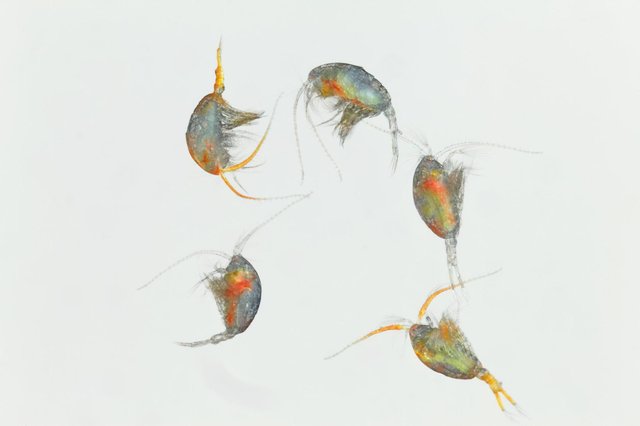SciencePop Nature Digest: One More Alien Fish, Super-Predator Spider and Tipsy Plankton
My conscience doesn't allow me to create short posts constantly using the information from Wikipedia as a basis, I think it's unfair to the readers. However, during the week I find dozens of interesting articles from the world of science, nature and space, which I really want to share with you.
So I decided to start making collections of the several news that will lead to harmony between my desire to tell something new and interesting, and unwillingness to make low-quality posts. The theme of today's digest is nature.
Shark-Xenomorph

image source
You may not believe me, but the science says this thing is a relative of the shark, yes even of the shark from the movie "Jaws". Maybe it's her cousin twice removed or a distant relative from the far galaxy of ugly creatures. The scientific name of this fish is Trigonognathus kabeyai or viper shark. And it looks like the Joker-alien for one simple reason: it's deep-sea fish. And as we know the enormous pressure and darkness do not add beauty to anyone.

Looks so that its upper jaw is much further than lower. Or as if it is quite a different creature in the shark's skin.
[[source]]
Do not be afraid, this pipsqueak will not be the cause of your screams “Something touched my leg under the water”. Viper shark reaches a size of 50-70 cm and lives at a depth of 270-360 meters, occasionally rises to a depth of 150 meters (unlikely you have such long legs, right?). This week biologists from Taiwan were lucky, they caught few of these sharks [source].

image source
This species is poorly understood because it dies on land, obviously due to the pressure drop, and the last time fell into the hands of scientists 30 years ago. So it remains a mystery how they use their strange jaws. However, like many deep-sea fish it possesses photophores- glands that allow the fish to glow to lure the prey. It is possible that the shark lures other fish glow top of the head and takes it back when attacks.
Super-Predator Spider

Don't worry, it's size only a few millimeters, so you can exhale. [image source]
If you are unable to understand its structure, let me help: his eyes are on the top on a long neck, and jaw exceeds the length of the body. Perhaps our list of the insects "Burn it with your house" considerably widened, because scientists found at once 28 species of these spiders, which used to be considered extinct. [source]
I'm an honest guy, so before writing about something I'm looking for the posts of other users on Steemit. What's the point writing about something if someone has already done it before you better? Therefore, I recommend you to read the @trumpman post, which he published two days ago. Excellent selection of information about pelican spiders and useful links.
However, I would like to add one interesting fact about these beauties, which will make them even more amazing. Spiders-pelicans belong to the Archaeidae family. In a sense, they are living fossils and represent the small copies of the spiders that have appeared on our planet for approximately 185 million years ago.

Probably 180 million years ago, this kid was 10 times larger. [image source]
Archaeidae are super-predators in the world of spiders. Tens of millions of years ago the food chains were not as diverse as today and predators did not have a large selection of prey. Therefore, many predators preferred to devour their less adapted counterparts and archaeidae stood on the top of the spider food chain. They are tyrannosaurs among spiders.
Go Home Plankton, You Are Drunk

Sober and law-abiding plankton moves in a circle. [image source]
Each of us has personal experience of how alcohol blunts our thinking ability: dancing on the bar, performing complex acrobatic tricks without preparation, launch fireworks out of your ass as a launch pad. In General, the chances of getting a Darwin award in the state of alcoholic intoxication significantly increase. It turns out that even plankton - cute harmless crustaceans and microorganisms can be tipsy.
Scientists have found that a large concentration of algae in a closed ecosystem leads to a strange behavior of plankton. Instead of trying to swim in a circular trajectory at a moderate speed (as usually arrives sober plankton), drunk plankton prefers to move in a straight line and 25% faster. This increases the chances of being eaten by 40-50%.

Tiny algae Alexandrium fundyense are the cause of toxins. [image source]
The fact that algae absorb large amounts of oxygen and produce toxins, because of which our little crustacean friends are starting to behave strange. Predictable trajectory makes them easy prey for predators, and the increase in speed allows them to get into the field of sight of a large number of hunters.
***
I hope you liked the digest of these short, but interesting news from the world of nature. I will continue to make digests on the theme of nature, technology, space and science 1-2 times a week.
#Sciencepop - science popularization. I suggest you use this tag in order to share interesting news, photos, stories from the world of science in a short format. Hundreds of scientific discoveries occur around the world every day. But they may contain insufficient data to create a full-fledged article or seem rather boring for usual readers, because of the strong scientific specifics. Although, I see that steemit community loves science in all its manifestations.

it looks horrible, thanks for sharing
omg :)
Wow this is really surprising thanks for teaching me something new today
Thank you for reading! I am writing precisely for such purposes that you can learning something new with me :)
👍👍👍
Really great article
buena publicación compañero. Un cordial saludo.